posted by Dave Arnold
It’s apple season! Really, apple season starts earlier than you think. It started almost a month ago already. Next week we’ll start posting our tasting notes on this year’s crop.
This is the first of many posts on apples. We love apples. Apples are delicious. Apples are worth close study. Nils and I even want to do a book on apples. Here is the background on the FCI’s apple project:
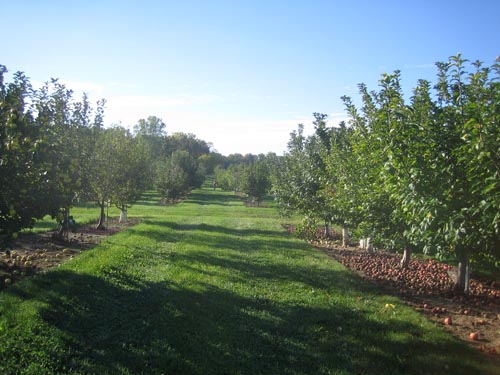
The apple orchard at Geneva (aka the germplasm repository).
As New Yorkers, it makes sense we would be interested in foods that grow at their best in New York State. Apples are one of those things. I’m not saying that the apples where you live aren’t good, just that New York’s are great. In fact, one of the greatest apple references of all time is The Apples of New York, a two volume set published in 1903 at the end of the golden era of fruit breeding. Read it on Google books here and here. As Americans (and Swedes living in America), it also makes sense that we’d be interested in foods that are deeply entwined in our history –apples fit the bill again. After years of mulling over apples, apple cider, apple history, apple jack, etc, we decided two years ago to do a project on apples. Our first step was to go to the Cornell/USDA agricultural extension in Geneva, NY in the middle of October to taste as many apples as we could.
The Geneva station houses an apple research facility as well as the largest collection of apple trees in the world. They have thousands of types. You can peruse their database here. Unfortunately, Nils had some meeting he was forced to attend so he had to cancel. Instead, I went to the apple collection with Harold McGee: master of culinary science, space, and time. You can read about his thoughts on the trip here.

This is how we found our way around the orchard. I printed out an answer key to the whole thing. Calville Blanc D'Hiver, by the way, is a great old French variety.
Strangely, the guys at Geneva thought that all we wanted to do was see the apple trees. They thought our interest was academic. When we pleaded to be allowed to stay with the apples, they looked at us and said, “You mean you actually want to taste the apples? Nobody has wanted to do that before.” McGee and I looked at each other and laughed. Why the hell else would we drive for 9 hours to the top of New York State? We ended up tasting hundreds of types of apple while we were there.
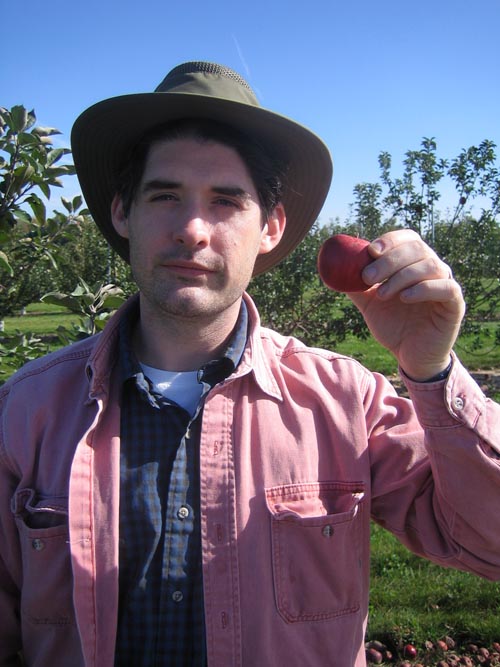
Flower of Kent. This is the apple that fell on Issac Newton's head. You might remember it from such stories as: Coming Up With the Theory of Gravity. Great story, great history, really crappy apple.
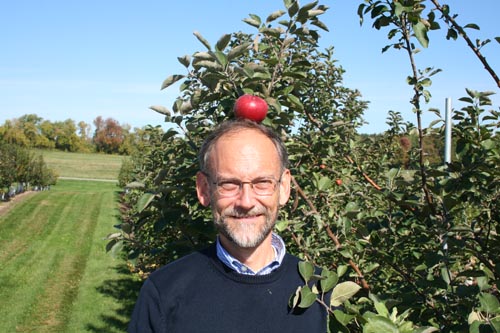
Here is McGee doing the William Tell with a Flower of Kent. It's about all that apple is good for.
We started with civilized tastes and ended by ripping bites out apples, taking a couple of chews, and spit/spewing the masticated paste out of our mouths in a giant cloud of juice that eventually settled all over us making us smell like a cider factory.
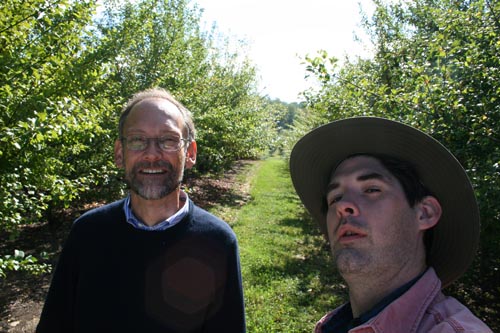
McGee and I after a lot of apples.
We were bloated and giddy as we left the orchard that night when it became too dark to read the signs on the trees. We went back again in the morning.
I learned more in those two days of tasting than I had in a lifetime of eating apples. I learned how to tell an overripe apple by feel, that the side of an apple facing the sun has a different flavor than the side in the shade, how thinning the crop of apples on a tree affects quality, how important refrigeration is to maintaining apple flavor and on and on.
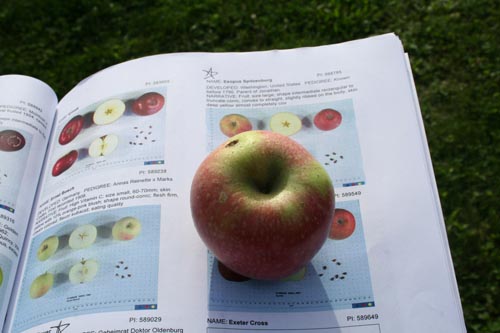
Esopus Spitzenburg. An old, highly acclaimed apple. Not so good if the tree isn't thinned, as we found out.
I also started developing an apple allergy to add to my throat-closing cherry allergy. Luckily, I can solve my apple allergy with Benadryl (so far). I was pounding Benadryl like candy the whole time I was in Geneva. Strangely, I am only allergic to some apples. I found out from doctor Susan Brown, an apple professor at Cornell, that scientists know which varieties of apples are more likely to trigger allergic reactions, they have just never published the data. Awesome. She also showed us some new apples she was working on: one tasted like anise and another was balanced in flavor but had over twice the amount of acid and sugar as a normal apple—apple on crack. Those really were awesome. They didn’t have names so you’ll have to contact her if you are interested.
McGee and I loaded up bags with a couple of dozen of the most promising varieties and headed back to The FCI where Nils and I tasted, baked, and juiced every apple we brought back. That’s when we made our first big apple culinary leap.
For years we had been using Granny Smith apples for juicing in the kitchen. They are tart and the juice looks good (if you use ascorbic acid to keep it green). It was our go-to juice apple. All that changed when we tasted the juice from Ashmead’s Kernel. Ashmead’s Kernel is an undistinguished looking russet apple that hails from early 18th century England, the world’s other apple-breeding superpower. It produces the finest juice I have ever tasted—rich, tart, complex, powerful. Then we got lucky. Nils found an orchard that produces great Ashmead’s Kernels that has distribution in New York City, Poverty Lanes Orchards of New Hampshire. I think we bought the rest of their remaining crop. We were swimming in Ashmead’s Kernel and we were happy. The problem was, when the Ashmead ran out, we were no longer happy with the Grannies! They are complete one-note Nancies by comparison—tart and apple-y, but nothing else.
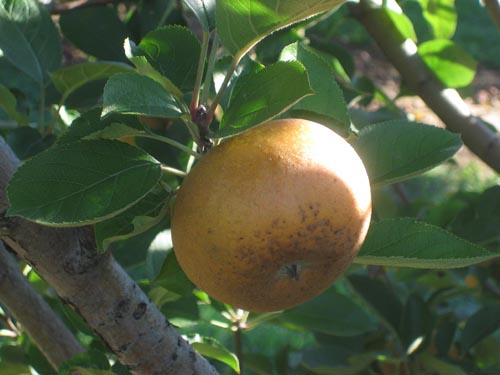
Ashmead's Kernel. Our holy grail of juice apples.
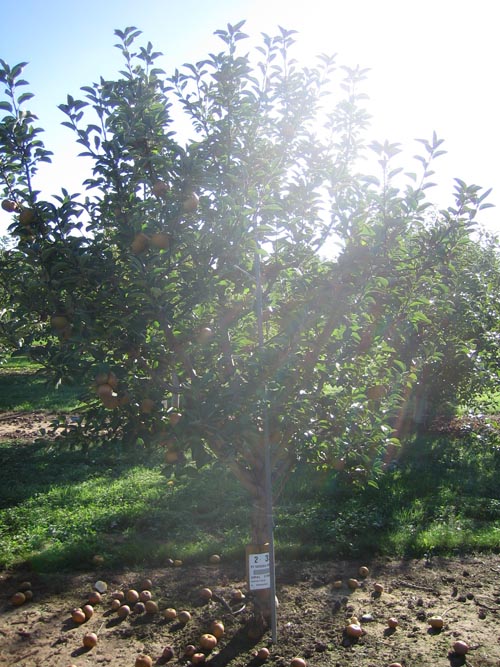
The Ashmead's Kernel tree in Geneva
That was only the beginning of our apple journey. There is more to come.
Here is a drink we made using Ashmead’s Kernel for a group of Kaiseki chefs who were visiting The FCI from Kyoto in October 2007:
The Kernel:
Ingredients:
Ashmead’s Kernel Apples
Ascorbic acid
Pectinex Smash XXL
Bulleit Bourbon
Carbon Dioxide
Technique:
Run the bourbon through a rotovap to remove the non-volatile oak. We love bourbon as it is, but the heavy oak tends to wipe out varietal notes of the apple. In this drink we wanted clear bourbon. Sorry to the purists.
Juice the apples with a champion juicer into a container with ascorbic acid. The ascorbic acid prevents the juice from turning color and developing oxidized flavors. Add 1.5 grams of Pectinex Smash XXL per liter of juice. Pectinex is an enzyme that breaks down the pectin in the juice and lets it clarify by itself. See here.
Mix clarified juice and clear bourbon to taste, chill to 0 degrees C and carbonate at 40psi.
Done.

Is there a ratio of apples to ascorbic acid to watch here? We add lemon to our Granny Smith Granité, but haven’t found the exact formula…
Howdy Roberto,
We really should have an exact ratio, but in reality we just add about a teaspoon to a full 4-6 inch 6th pan. We never use lemon because it imparts more flavor and acidity (all the extra citric acid).
Finally got around to testing it. Didn’t take the ratio either, but the result was much better.
you should post about Granités, it’s so avant garde
i have 2 buisness plans i shopped around here in tampa on the theme of a restaurant entirely based on apple in almost every aspect of the menu. the place was gonna be called (R.D.A.) Red Delicious Apple. didnt go over to well. it seems Florida is more into oranges. Go Figure. Ya that Asmead’s variety is amazing. Breaburn is my goto its good for cooking, juicing and just eating
i am so incredibly jealous – when i first ready about the extension orchard in The Botany of Desire, i immediately wanted to go there and taste them all, just as you did.
i first tasted Ashmead’s Kernel as part of an apple tasting in a class on fruit crop production – even though the sample we tried had been in cold storage for nearly a year and had shrivelled significantly, every student rated it best in flavor.
imagine my pleasant surprise when i see a bushel of fresh Ashmead’s Kernel appear in the walk-in at a restaurant in which i’m interning.
thank you for this post – it’s time people rediscover this incredible apple.
Howdy Jeffje,
Yeah, it really is a great apple.
No wonder you didn’t want any of the apple tart I offered you yesterday! Is the Geneva Station open to anyone? I’d love to see (and taste) as many as possible. Especially the “crack apple” and the Ashmead’s Kernel.
Ha ha. It wasn’t that, I try not to snack too much at work. I don’t know what the visiting rules are. I called and mentioned the school, the apple project, possible press, McGee, etc. I pulled out all the stops.
Great article. I grew up not far from Poverty Lane orchards. Summertime food up in New England is so delicious. Farmers up there seem to have an appreciation for craft.
Two questions, one more apple-related than the other:
1) Do you do (or know of anything that one could do) to specially encourage the production of good varieties? Obviously, buying and blogging *should* be enough, but the industry is pretty slow-moving. Are there food industry back channels where you can put in requests?
2) Is there magic in the “roto” part of the rotovap? You mention in your excellent primer that it makes it faster (due to enlargement of the surface area) and serves to make the heating more even. Is there any reason one of those magnetic stirrer bars wouldn’t work about as well? It seems like the “roto” part adds a lot of complexity and expense to the device.
Hi Jeremiah,
Thanks for the questions.
Re 1: I don’t have any good answers, but will be addressing some of the problems in my next apple post.
Re 2: The magnetic stir bars (I think) won’t suplly the same large surface area as a properly loaded rotovap. They are loads better than nothing, but not quite as good (my guess from the literature and from unscientific personal observation). My new rotovap will use a stir-bar like contraption, but will spin a cylinder inside the vacuum. that should get rid of the vacuum seal and retain the large surface area.
Nice! Must have been a good trip (minus all of the benadryl…) Did you get my text this morning? It only required a yes or no response as i know you like, ha ha
Yep. Espuma, Espuma.
For anyone that is looking, Pectinex Ultra SP-L is available at http://www.modernistpantry.com/pectinex-ultra-spl.html. Pectinex Smash XXL is no longer available from the manufacturer, but is not required. You can just use straight Pectinex Ultra SP-L.